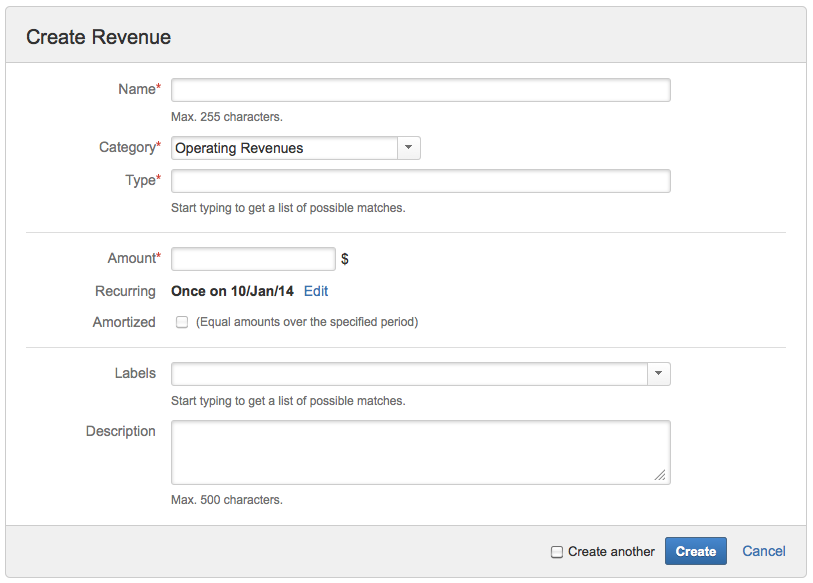TODO DESCRIPTION. Adding a revenueTo add a revenue, either click the Create Revenue button or hit the "a" (for add) shortcut key. This brings the revenue edition dialog. Check the "create another" box at the bottom of the dialog in order to create many revenues in sequence
The following table describes the various fields of the revenue edition dialog.
OperatingIncome derived from sources related to a company's everyday business operations. For example, sales, consulting services incomes. Non-OperatingThe portion of an organization's income that is derived from activities not related to its core operations. Non-operating income would include such items as dividend income from investments, gains incurred due to foreign exchange. Revenue recurrence works same as budget or actual If you add Custom revenue fields in the Folio configuration screen they will available in revenues. Note that you can enter any value up to 255 characters. Also that those values will displayed in the revenue details column under the "Extra Information" section.
Editing revenueSelect an existing revenue to modify by clicking on it and then either click on the drop-down menu on the top-right part of the revenue details view (on righthand side of the screen) and select the Edit option or hit the "e" (for edit) shortcut key. This will bring up the revenue edition dialog. For a detailed description of the revenue edition dialog, refer to Adding a revenue section above. Deleting an revenueSelect an existing revenue to delete by clicking on it and then either click on the drop-down menu on the top-right part of the revenue details view (on righthand side of the screen) and select the Delete option or hit the "d" (for delete) shortcut key. This will bring up a dialog to confirm revenue deletion. Click the Delete button to confirm the deletion, or Cancel link to abort deletion. Deletion is permanent, thus make sure you really want to delete a revenue before proceeding. You can delete multiple revenues or even a mix of consulting services and revenues at once by selecting multiple lines in the Revenue list (by pressing and holding the Control key while clicking the consulting services and revenues to delete). You can then delete the selected revenues the same way you delete a single revenue. Note that in this case, the deletion confirmation will inform you of how many items are about to be deleted. Revenue amountsThe Revenue page shows the calculated amount for each revenue and revenue groups (by type). The amount of a revenue is calculated by multiplying its payment amount by the number of payments. Amoun = Number of payments x Payment amount The number of payments depends on the recurrence definition for that revenue and the portfolio's time frame. Only revenues occurring (inclusively) between the portfolio's start and end dates (see Folio Configuration) are computed. Note also that non-working days are not taken into account (e.g. a rent income won't be skipped if the incurrence date is a holiday). Example 1 - Recurrent expense Amount: 100$
Example 1 - Amortized recurrent expense Amount: 100$ (amortized)
Revenue detailsWhen selecting an revenue on the Revenue page, more information on that revenue is displayed in the details panel on the right. You can also select multiple revenues or even a mix of consulting services and revenues at once by selecting multiple lines in the revenues (by pressing and holding the Control key while clicking the consulting services and revenues). This gives you an aggregated view showing the total costs of the selected revenues. Attaching files to a revenueYou can attach files to a revenue in order to keep related documents handy (invoices, quotations, etc.). To attach files to a revenue, select it and then click button Attach Files in revenue details panel on the right. This will bring up a dialog where you can pick a file (or multiple files simultaneously, if your browser allows it) and enter an optional comment. | Related pages: |
This is the documentation for an older version of Folio and has been moved to the Tempo instance.
Please view the Folio Category in the Tempo Products Wiki Categories for all versions of Folio's Documentation.
General
Content
Integrations
